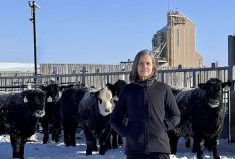Glacier FarmMedia – Should agriculture’s decreases in carbon emissions be based on intensity of use per unit of food, or measured in the total volume of reductions?
That’s the crux of a philosophical discussion happening in agriculture and showcased by competing reports on how to reduce greenhouse gas emissions in agriculture.
Why it matters: How farmers are required to decrease carbon emissions will have an effect on farm management practices and farm income, as well as public perception of agriculture.
Read Also

Your best (and easiest) holiday dainty tray
Make-ahead recipes, store-bought goodies and co-operation with friends and family: Here’s how to throw together a stunning, low-stress tray.
The Smart Prosperity Institute (SPI) at the University of Ottawa recently hosted a panel discussion of farm sector representatives to debate the group’s recent report on agriculture sector “clean growth.”
A Fertilizer Canada representative argued that Canadian farmers should be rewarded for decreasing the amount of GHG emissions per unit of food produced, while a Farmers for Climate Solutions (FCS) representative called instead for the federal government to set absolute targets and create a plan for achieving those targets regardless of change in total yields.
“I don’t think farmers want to be that group,” said FCS director Brent Preston, referring to the report’s assertion that international climate-related commitments will see the Canadian agriculture sector maintain the status quo while other sectors lower their emissions.
“We don’t want to be the only sector that’s not doing its part.”
The federal Agriculture Ministry is listed as the sole outside funder for the SPI report.
Both Fertilizer Canada and FCS have made recent headlines through efforts to influence federal climate-related policy.
Farmers for Climate Solutions has grown its influence with the federal government by offering clear recommendations for how agriculture could be part of a climate change solution. That’s been shown as the group has appeared alongside Agriculture and Agri-Food Minister (AAFC) Marie-Claude Bibeau.
The Fertilizer Canada report expressed concern about the federal government plan to reduce absolute carbon emissions through a 30 per cent reduction in on-farm fertilizer use by 2030. Nitrogen fertilizer is a major contributor to agriculture’s carbon emissions.
The organization, a coalition of nutrient manufacturers, marketers and distributors, cited a report it commissioned that was released in September that said, “cutting fertilizer use to reduce on-farm emissions could cost growers nearly $48 billion over the next eight years.”
The SPI report was published in October. Its focus was driven by input gathered during a January 2020 workshop in Ottawa that included “representatives from government, industry, academia, and environmental non-governmental organizations.”
Priorities were presented to workshop attendees and those receiving the most support were nitrogen fertilizer management, improving soil health, circular economy approaches to reducing environmental impacts and targeting methane emissions from cattle.
“While livestock production currently contributes approximately 60 per cent of all GHG emissions (excluding on-farm fuel use) in the agriculture sector, this share has dropped significantly since 2005,” states the report.
Lower cattle numbers are one reason, but SPI research associate Ryan Tougas-Cooke told the Nov. 4 panel discussion that genomics and enhanced feed efficiency are also effective and emerging strategies.
Emissions tied to fertilizer use have been more elusive, the report suggests.
“Methane (largely from cattle) is estimated to remain in the atmosphere for a relatively short… time, about 12 years; by contrast, nitrous oxide (from fertilizer production) lasts for an estimated 114 years in the atmosphere,” the report states.
And “the shift from perennial to annual cropping systems – particularly in Eastern Canada – and intensification of fertilizer use has resulted in a slow but steady upward trend in the GHG intensity of crop production since 2005.”
The scenario presented is that on the Prairies, gains in conservation tillage have increased the carbon sequestration capabilities of the region’s soils but not enough to offset overall increases in fertilizer use.
Meanwhile, in Eastern and Central Canada, GHG emissions from livestock have decreased but not enough to offset the overall increase in nitrous oxide emissions due to the conversion of land from hay and pasture to nutrient-hungry crops.
Fertilizer Canada executive vice-president Clyde Graham, a Nov. 4 panellist, said AAFC’s analysis of GHG emissions fails to adequately account for the potential gains if more farmers adopt what the industry is promoting as “4R Nutrient Stewardship” (right time, right place, right amount, right product).
He called on government to focus on “intensity targets” that reduce emissions per unit of grain or oilseed grown.
“Any plan to reduce greenhouse gas emissions must be done through sustainable agricultural intensification,” Fertilizer Canada said in its Sept. 27 news release. This approach “allows for significant reductions in agricultural emissions without risking Canada’s contribution to global supply of food.”
Preston, a Creemore, Ont.-area vegetable grower who is also president of the Ecological Farmers Association of Ontario countered that “absolute” targets must be established and met.
The two panellists agreed that Canada lags behind other jurisdictions in financially supporting farmers who adopt climate-friendly practices.
Graham said more government resources should be devoted to support the 4R Nutrient Stewardship program, including its recognition around the world as a contributor to climate-friendly production.
Preston said the lion’s share of federal funding in support of farmers comes through business risk management (BRM) programs but these aren’t driven by climate change solutions. The failure of some crop insurance programs to allow intercropping is one example.
Emissions reduction should instead be at the forefront, he said.
“We want to make sure we don’t have disincentives in the BRM programming that prevent farmers from using climate-friendly practices.”
Before the panel discussion, SPI executive chair Stewart Elgie outlined the “Clean Growth” report, noting Canadian agriculture faces two big challenges: taking advantage of future opportunities to help feed the world, and decreasing its climate change impact.
He described Canadian agricultural policy as “a mix of carrots and sticks” but argued for the need for more creative approaches.
– Stew Slater is a contributor to Farmtario. His article appeared in the Dec. 13, 2021 issue.















